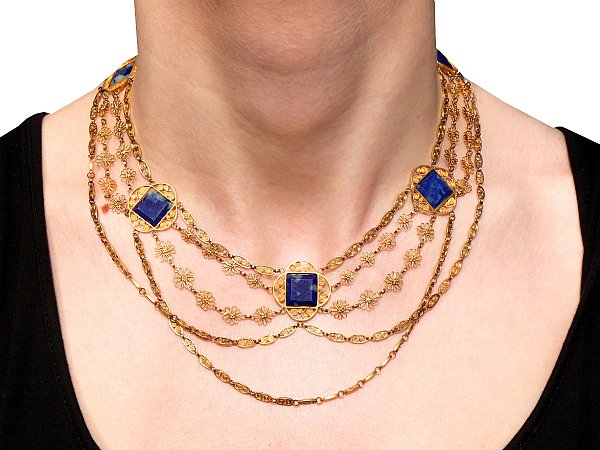The Victorian era, which lasted from 1837 to 1901, was marked by significant transformations in society, politics, and culture. Named after Queen Victoria, this period greatly influenced fashion and jewellery, with necklaces becoming a key accessory for women. Whether they were worn to symbolise love, mourning, or to display wealth and taste, necklaces were vital in conveying the personal and cultural values of the time.
Victorian jewellery transformed throughout the era, mirroring the evolving tastes and circumstances of the time. From the natural, romantic designs of the early years to the darker themes of mourning jewellery, and ultimately to the elaborate artistry of late-Victorian styles, each phase introduced new materials, techniques, and motifs. Necklaces, especially, experienced significant design changes, becoming treasured items that conveyed stories of love, loss, and beauty.
Early Victorian Necklace Styles (1837-1860)
Romantic Influence
The early Victorian era, commonly referred to as the Romantic Period, was deeply influenced by nature and the ideals of love and emotion. Necklace designs showcased motifs inspired by flowers, leaves, serpents, and various other natural forms, mirroring the era’s enchantment with the organic world.
Sentimental Jewellery
Sentimentality was at the heart of many early Victorian necklaces. Lockets and pendants containing locks of hair, miniature portraits, or other personal mementos were popular, serving as intimate keepsakes of loved ones.
Popular Materials
Gold was a staple of early Victorian necklaces, often combined with enamel, turquoise, coral, seed pearls, and semi-precious stones like garnets and amethysts. These materials created vibrant, detailed pieces that were both beautiful and meaningful.

Common Styles
Chokers, simple chains, and lockets were among the most common necklace styles during this period. Many pieces featured delicate craftsmanship, with intricate metalwork and small, sentimental embellishments.
Mid-Victorian Necklace Styles (1860-1885)
Mourning Jewellery
The death of Queen Victoria’s beloved husband, Prince Albert, in 1861 led to a widespread trend in mourning jewellery. Necklaces during this time were often crafted from black materials such as jet, onyx, and black enamel, symbolising grief and loss.
Gothic Revival and Archaeological Influence
Mid-Victorian necklace designs took inspiration from the Gothic Revival and the growing interest in archaeological discoveries. These influences led to necklaces adorned with symbols and patterns reminiscent of the Renaissance, Middle Ages, and ancient civilisations, resulting in bold and dramatic pieces.
New Materials and Techniques
The mid-Victorian period saw the introduction of diamonds, amethysts, garnets, and filigree work in necklace designs. These intricate details brought a level of sophistication and complexity that reflected the era’s growing fascination with opulence and craftsmanship.
Common Styles
During this period, popular styles included drop necklaces adorned with cascading gemstones and lockets that incorporated braided hair, reflecting the ongoing trend of sentimental jewellery. Additionally, pendant necklaces, frequently highlighting striking gemstones, also became quite fashionable.
Late Victorian Necklace Styles (1885-1901)
Aesthetic Movement
The Aesthetic Movement, known for its focus on artistic expression and beauty, significantly impacted late Victorian jewellery. During this time, necklace designs grew more elaborate and playful, frequently featuring natural themes like flowers and birds.
Transition to Edwardian Styles
As fashion evolved in the late Victorian years, necklaces started to become lighter and more delicate, paving the way for the upcoming Edwardian era. These new designs showcased a shift towards elegance and simplicity, departing from the heavier, more ornate styles of earlier periods.
Materials and Techniques
Platinum, diamonds, and sapphires were commonly used in late Victorian necklaces, with intricate metalwork and fine details showcasing the evolving craftsmanship of the time.
Common Styles
Lavaliere necklaces, festoon necklaces, and multi-strand chains gained popularity during this time, known for their light, flowing designs and the delicate incorporation of gemstones.
Iconic Victorian Necklace Motifs
Symbolism in Jewellery
Symbolism was an important aspect of Victorian jewellery. Popular motifs such as hearts (symbolising love), crosses (representing faith), anchors (denoting hope), and crescents (embodying femininity) carried profound meanings for the wearer, transforming necklaces into items that were not only decorative but also deeply expressive.

Influence of Queen Victoria
Queen Victoria’s personal preferences had a significant impact on the jewellery trends of her time. She brought attention to snake motifs, representing eternal love, along with lockets and other sentimental items. Notably, her mourning jewellery made a lasting impression on the styles of Victorian necklaces.
How to Identify Authentic Victorian Necklaces
When identifying genuine Victorian necklaces, it’s important to focus on certain key features, including the materials used (like gold, jet, and turquoise), the level of craftsmanship, and unique hallmarks. Look closely at the intricate details, as Victorian jewellery typically showcased hand-crafted elements that are challenging to reproduce in contemporary versions.
Tips for Distinguishing Genuine Pieces from Reproductions
Examine the wear and patina that develop naturally over time, along with the weight and texture of the piece. Genuine Victorian necklaces typically exhibit signs of age while still showcasing their beauty and craftsmanship. Seek advice from a trusted jeweller or antique expert to help confirm authenticity.
Caring for and Styling Victorian Necklaces Today
Best Practices for Preserving Antique Jewellery
To preserve Victorian necklaces, store them in a dry, cool place, away from direct sunlight. Clean them gently with a soft cloth and avoid using harsh chemicals or abrasive cleaners that could damage delicate materials.
Incorporating Victorian Necklaces into Modern Fashion
To preserve Victorian necklaces, store them in a cool, dry place, away from direct sunlight. Use a soft cloth for gentle cleaning, and avoid harsh chemicals or abrasive cleaners that could damage the delicate materials. If you want to maintain the Victorian theme, a Victorian silver jewellery box would be an ideal way to store the jewellery.


Victorian necklace styles showcase the artistry, craftsmanship, and emotional depth of the era. Ranging from romantic chokers to intricate mourning jewellery, these necklaces serve as timeless symbols of both personal and cultural history. Whether you’re a collector or just an admirer, Victorian necklaces provide a fascinating glimpse into the past while continuing to influence modern fashion.
We’d love to hear from you! Share your favourite Victorian necklace styles or personal collections in the comments below. Whether you own a piece or simply appreciate the beauty of the era, join the conversation and celebrate the elegance of Victorian jewellery.
Additional Resources:














